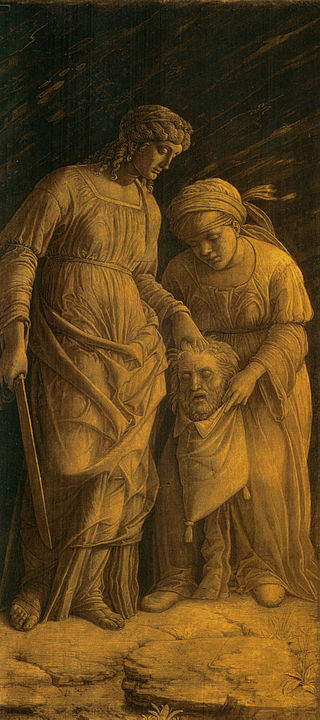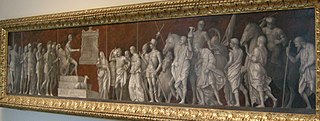Brizo is an ancient Greek goddess who was known as the protector of mariners, sailors, and fishermen. Brizo was also known as a prophet specializing in the interpretation of dreams and she would interpret the dreams of humans as a prophecy.

Andrea Mantegna was an Italian painter, a student of Roman archeology, and son-in-law of Jacopo Bellini.

Joseph Anthony Mantegna is an American actor. He has starred in the CBS television series Criminal Minds since 2007 as FBI Supervisory Special Agent David Rossi. He has voiced the recurring role of mob boss Fat Tony on the animated series The Simpsons, beginning with the 1991 episode "Bart the Murderer", as well as The Simpsons Movie (2007).

The Sistine Chapel ceiling, painted in fresco by Michelangelo between 1508 and 1512, is a cornerstone work of High Renaissance art.

Grisaille is a painting executed entirely in shades of grey or of another neutral greyish colour. It is particularly used in large decorative schemes in imitation of sculpture. Many grisailles include a slightly wider colour range.

The Delphic Sibyl was a woman who was a prophet associated with early religious practices in Ancient Greece and is said to have been venerated from before the Trojan Wars as an important oracle. At that time Delphi was a place of worship for Gaia, the mother goddess connected with fertility rituals that are thought to have existed throughout the ancient Mediterranean world. As needed to maintain the religious tradition, the role of sibyl would pass to another priestess at each site.

The Sistine Chapel ceiling, painted by Michelangelo between 1508 and 1512, is one of the most renowned artworks of the High Renaissance. Central to the ceiling decoration are nine scenes from the Book of Genesis of which The Creation of Adam is the best known, the hands of God and Adam being reproduced in countless imitations. The complex design includes several sets of individual figures, both clothed and nude, which allowed Michelangelo to fully demonstrate his skill in creating a huge variety of poses for the human figure, and have provided an enormously influential pattern book of models for other artists ever since.

The San Zeno Altarpiece is a polyptych altarpiece by the Italian Renaissance painter Andrea Mantegna created around 1456–1459. It remains in situ in the Basilica di San Zeno, the main church of the Northern Italian city of Verona. Mantegna's style mixes Greco-Roman classical themes along with Christian subjects in this altarpiece. The central panel, along with the three paintings that comprise the predella, were taken in 1797 by the French. While the main, central scene was returned by the French to Verona in 1815, the three predella paintings in Verona today are copies, since the original ones remain in France at the Louvre (Crucifixion) and in the Musée des Beaux-Arts in Tours. The paintings are made with tempera on panel; not oil as mistakenly identified in one source.

The Camera degli Sposi, sometimes known as the Camera picta, is a room frescoed with illusionistic paintings by Andrea Mantegna in the Ducal Palace, Mantua, Italy. During the fifteenth century when the Camera degli Sposi was painted, Mantua was ruled by the Gonzaga, who maintained Mantua's political autonomy from its much stronger neighbors Milan and Venice by bidding their support out as a mercenary state. By commissioning Mantegna to paint the chamber, Ludovico III Gonzaga, the Marquis of Mantua, sought to give the Gonzaga rule more cultural credibility at a time when other Northern Italian courts such as the Ferrara were commissioning their own “painted chambers”.

The Adoration of the Magi is a painting of 1633–34 by the Flemish Baroque artist Peter Paul Rubens, made as an altarpiece for a convent in Louvain. It is now in King's College Chapel, Cambridge, in England. It measures 4.2 m × 3.2 m.

Judith with the Head of Holofernes is an Italian Renaissance painting attributed to Andrea Mantegna or to a follower of his, possibly Giulio Campagnola. Painted in tempera in around 1495 or 1500, it depicts the common artistic subject of Judith beheading Holofernes.

The Golden Bough is one of the episodic tales written in the epic Aeneid, book VI, by the Roman poet Virgil, which narrates the adventures of the Trojan hero Aeneas after the Trojan War.
Judith and Holofernes may refer to:

The Mantegna funerary chapel is one of the chapels of the Basilica of Sant'Andrea, Mantua. It houses the tomb of the painter Mantegna and his last two paintings – Baptism of Christ and Holy Family with St John the Baptist, St Elizabeth and St Zacharias (1504–1506). Its frescoes from 1507 were painted by his sons Ludovico and Francesco and by a young Correggio. The tomb bears a bronze figure of Mantegna by Gianmarco Cavalli.

Exemplary Women of Antiquity is a set of paintings produced between 1495 and 1500 by Andrea Mantegna. They show the Carthaginian noblewoman Sophonisba poisoning herself to avoid being paraded in a Roman triumph, the Roman Vestal Virgin Tuccia proving her chastity by carrying water in a sieve, Judith with the head of Holofernes and Dido holding Sychaeus's funeral urn. Infrared reflectography has uncovered a signature on the back of Judith reading And.a Mantegnia. P[inxit].. Sophonisba and Tuccia are egg-tempera on poplar panel, whilst Judith and Dido are glue-tempera on linen canvas.

The Continence of Scipio or An Episode from the Life of Publius Cornelius Scipio is a painting in oils on canvas by the Italian Renaissance artist Giovanni Bellini, dating to 1507–08 and now in the National Gallery of Art in Washington, D.C.

Samson and Delilah is a painting of circa 1495–1500 in glue tempera on linen canvas by Andrea Mantegna, now in the National Gallery, London.

Judith with the Head of Holofernes is a c. 1495 glue tempera on canvas painting by Andrea Mantegna, now in the National Gallery of Ireland in Dublin. It is in the grisaille style.

Occasio and Poenitentia is a c.1500 grisaille fresco by Andrea Mantegna or his school. It is now displayed in the Palazzo San Sebastiano in Mantua after a long period over a fireplace in the Palazzo Cavriani. It was on display in Mantua's Palazzo Ducale from 1915 to 2002.

The Adoration of the Kings is a small oil painting on panel of c. 1500 by Bramantino in the National Gallery, London. In it the Holy Family and the Magi are, unusually, joined by an adult John the Baptist, whose Baptism of Christ was celebrated on the same day as Epiphany in the liturgical calendar. At 56.8 cm (22.4 in) × 55 cm (22 in), it was probably commissioned for private use by an individual rather than for placing in a church, but nothing is known about its early history. The panel entered the National Gallery in 1916 as part of the Layard Bequest.


















